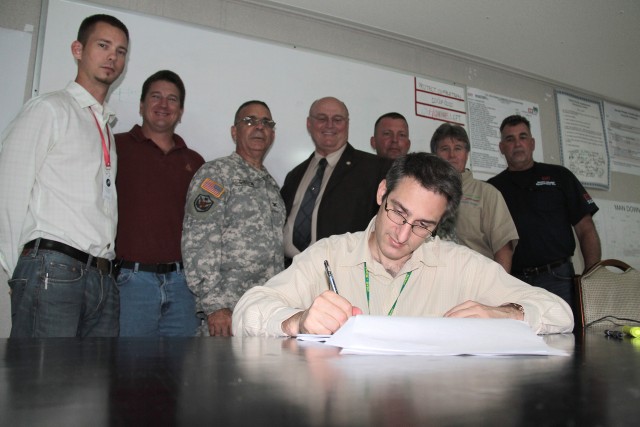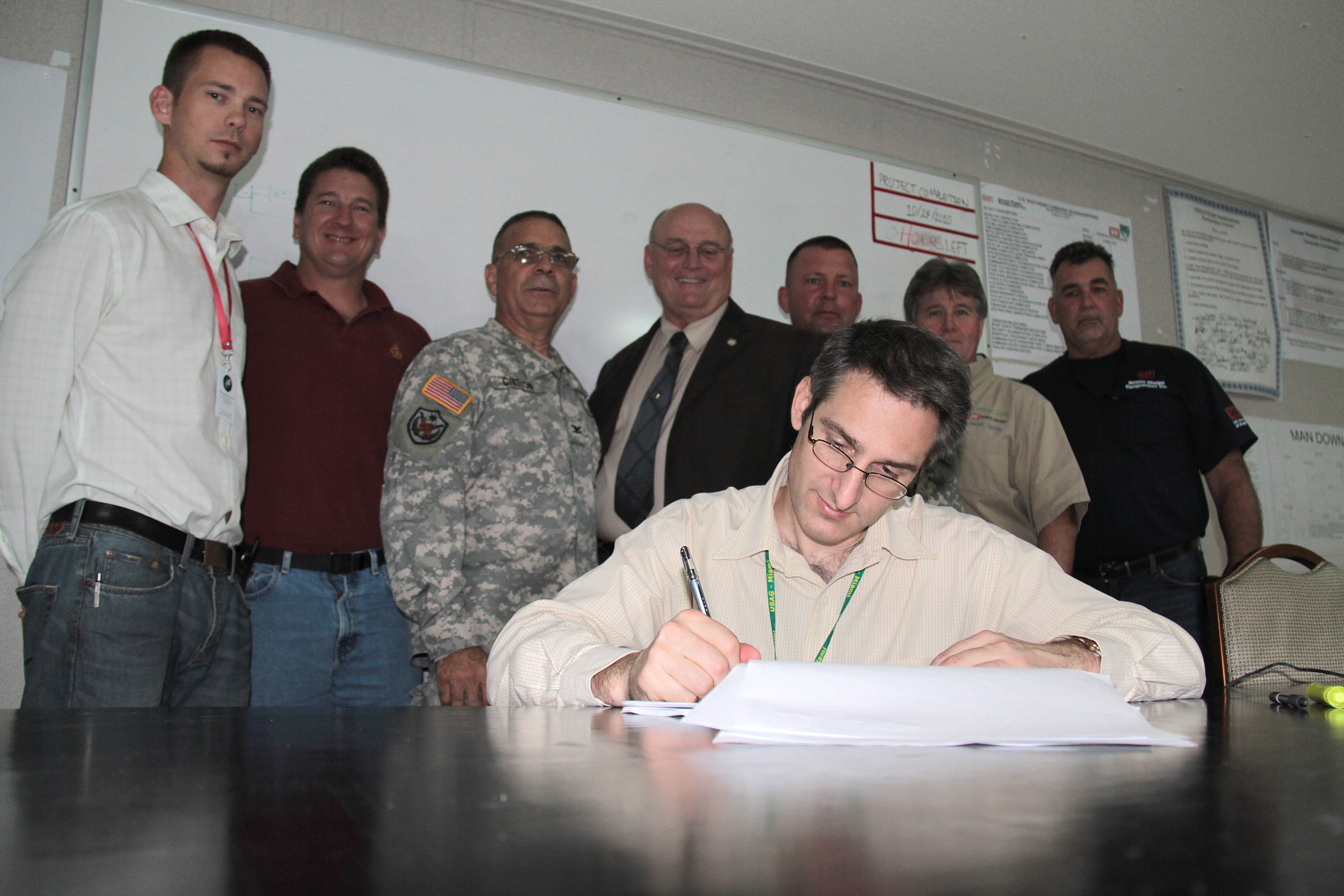
In a modest ceremony representing the transfer of more than a quarter-billion dollars of property, John Burgess, U.S. Army Garrison-Miami's Director of Public Works signed a memorandum taking ownership of the new SOUTHCOM Headquarters Complex in Doral.
The signature signifying the beneficial occupancy date is one of the final steps leading up to the planned Dec. 17th Ribbon-Cutting.
"This has been a real team effort," said Col. Norberto Cintron, chief engineer for U.S. Southern Command. "From the funding from Congress, working with the State of Florida and City of Doral, to the awarding of the project - there has been a lot of effort."
"What beneficial occupancy means is that you can use the building for its intended purpose," said Dennis W. Newell, resident engineer for the project. Down the final stretch, there were as many as 15 to 20 people from primary contractor Hensel-Phelps and the Army Corps of Engineers dedicated to inspection and quality control processes.
"Quality was one of our partnership goals," Newell said, "the key is making sure you have clear standards defined in the contract."
The transfer does not mean that Hensel-Phelps job is done.
"Essentially this is a real-property transfer document," Burgess said, holding the 40-page modification list in his hand. It quantifies the number and scope of buildings; and transfers that real property from the construction contractor to the government as "complete" minus some few things that need to be fixed after the fact.
"We still have a lot of work to do," Cintron said. Construction on the AAFES facility begins next month, and a commissary is still being deliberated in congressional committee. "We hope they support the service members here and approve it."
"You will see some hard hats on people performing modifications and other work, but for SOUTHCOM people, no more hard hats," Newell said.
Making the building ready and keeping it running is a big step for the Garrison. The document also puts the facility in the Army's real property system that generates funds to operate and maintain that property, Burgess explained.
"My work is just starting," Burgess said. "We are fully responsible for maintaining this campus - the utilities, facilities and grounds - from security and maintenance to changing light bulbs and issuing keys. We probably have not expanded our capacity the way we should have, and there will be bugs to work out over the next few months."
Security throughout the new building is more sophisticated. "I open my door with a fingerprint," Burgess said.
"The average employee is going to see more space and openness and more capability to meet and collaborate with each other, even if some of the individual spaces are the same or slightly smaller."
"It is a tremendous advancement for our capability," Cintron said. "When we did our operations in Haiti, we were running operations out of several disparate locations. Now we have a Joint Operations Center that can support what we want to do."
The new headquarters adds this capability while minimizing impact on resources, due to its design, which was required to be LEED Silver certified.
"Just one of the things you will see are two large ponds," Cintron said. The 35-foot-deep retaining ponds allowed the complex to be built above the 100-year flood level, and will cut water usage by supplying irrigation and recyclable water to the complex, reducing the impact.
Additionally, he said, the building was constructed to maximize outside lighting to the cubicles, rather than private offices, as in traditional office buildings. "This is contrary to the old way of construction, and more natural light means less lighting is required by the building itself."
"The significance of LEED Silver is that we have a building that is designed and will be maintained to lead to better energy efficiency and less consumption," Newell said. "This benefits the Army by saving dollars that can be spent somewhere else. It also means less dependence on fossil fuels."
"LEED is a point system, the current Army standard for design and construction," Burgess said. LEED construction takes into account the materials and energy efficiency. "Our overall impact will be more, because this represents three times the space we had; but per square foot of facility, you will see a much smaller impact on the environment."
It is difficult to actually compare the facilities, Burgess said, because until now, SOUTHCOM and the Garrison did not have the infrastructure to perform their missions as effectively as they will. "Increased capacity - for example, to hold conferences - and increased capability to do other things to perform the mission, all part of a long-term solution."
That long-term solution is important, said Audy Snodgrass, garrison manager. "Without the support of both the State of Florida and Congress, this might never have happened."
"When you build a command and control headquarters," Newell said, "it's going to be complicated."
"From the automatic lights, to the robust electronic security system, to the fact that I can control temperatures from my office with the building management system; the guts of this building are much smarter," Burgess said. "Even better, it should all be invisible to the user."
The building is designed to withstand maximum wind speeds of 185 miles-per-hour, which Newell says far exceeds current Miami-Dade and Florida code requirements.
"The building has been wind-load tested, and can actually shift up to three inches," Cintron said. "The joints and single-tilt wall construction - the way it was built and came together is full of interesting features."
The building also uses power from two different substations, has 10 MW of backup generator power and other life sustaining and communications equipment. "Other than our contributions in Haiti, completion of this has been the most satisfying moment of my time here at SOUTHCOM."
That amazing storm resistance - and the information management specifications - made the building a career-high point for Newell.
"There are so many different players and people involved. This is the most complex and challenging, but also the most rewarding job I've ever worked on."
The building was efficient enough to win the Miami-Dade American Society of Civil Engineers Project of the Year Award. "The structural designer and sub-contractor did a great job, it was a pleasantly surprising award for us," Newell said.
Burgess has been involved with smaller jobs that nonetheless took longer and involved all sorts of reprogramming budget requests and rebuttals.
"To bring a project from a good idea to fruition in the time in which this was done is incredible," Burgess said. "The Army Corps of Engineers, Hensel-Phelps and the other professionals involved with this project have done an incredible job to bring it from where it was three years ago."
Many of the same ACOE staff and contractors on this project will be moving on to begin the Special Operations Command - South headquarters near Homestead Air Reserve Base. Newell will be working on the Air Force Tactical Applications Center at Patrick AFB, Fla.
Photo: (l to r, rear) Matthew Sears, Project Engineer Hensel-Phelps Construction Company; Zachary Kluckowski, Army Corps of Engineers; Col. Norberto Cintron, Chief Engineer, U.S. Southern Command; Audy Snodgrass, Garrison Manager, U.S. Army Garrison-Miami; Lt. Col. John Pilot, ACOE; Dennis Newell, Resident Engineer, HPCC; and Kevin Stewart, Project Superintendent, HPCC; observe as John Burgess, USAG-Miami Director of Public Works, signs the documents transferring ownership of the SOUTHCOM Headquarters Complex to the Army.

Social Sharing